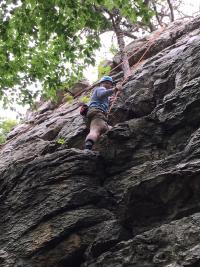Outdoor rock climbing simply means that you will be ascending natural rock formations (boulders, cliffs, mountains, etc.) utilizing the features they provide. A roped safety system may or may not be used because “outdoor rock climbing” encompasses a wide range of styles/systems, from bouldering (no rope involved), to top roping a single pitch route, to aid climbing a big wall, to traditional climbing multi-pitch routes in the mountains. (see definitions below).
Pennsylvania as a whole is stacked with a lifetime’s worth of bouldering and single pitch climbing. Pennsylvania has very limited multi-pitch (but it can be found!) and ice climbing, with no alpine or big wall climbing at all.
Cumberland Valley, and surrounding counties, offer a lot of bouldering and single pitch rock climbing opportunities. Some of the outdoor rock climbing spots in Cumberland Valley, plus, surrounding counties, that offer outdoor rock climbing opportunities are (not exhaustive):
Pole Steeple – Michaux State Forest and Pine Grove Furnace State Park. Climbing styles: top roping and traditional lead climbing.
White Rock Acres – just South of Boiling Springs, PA in the White Rock Acres development. Climbing styles: top roping and traditional lead climbing
Whiskey Springs – near Boiling Springs, PA off of Whiskey Springs Rd, located on the Appalachian Trail. Climbing styles: bouldering
Walnut Bottom – near Walnut Bottom, PA off of High Mtn Rd. Climbing styles: bouldering with limited top roping
Tumbling Run – within Michaux State Forest and near Pine Grove Furnace State Park off of Woodrow Rd. Climbing styles: bouldering
Shaffer Rocks – within Michaux State Forest near South Mountain, PA off of Old Forge Rd and Swift Run Rd. Climbing styles: mostly top roping with limited traditional lead climbing and bouldering.
Pond Bank – within Michaux State Forest near Pond Bank, PA. Climbing styles: mostly traditional lead climbing and top roping, with very limited sport lead climbing and bouldering.
Types and styles of outdoor rock climbing
Here are some very simple definitions that are just introductions to outdoor rock climbing systems/styles.
Free climbing – using your own body, nothing more, to ascend the rock. The rope (safety system) is only there in case the climber falls and/or for lowering. The styles of free climbing include bouldering (no rope involved), top roping, sport lead climbing and traditional lead climbing.
Aid climbing – using only rock climbing gear to ascend the rock, totally relying on the safety system the entire way. Aid climbing is mostly used when a section of rock is too hard to free climb, or in big wall and/or alpine climbing.
Bouldering – climbing (usually hard) boulders and/or cliffs on average up to about 15ft off of the ground, with no ropes involved; often people bring portable pads to comfort their landings if they were to fall.
Single pitch – this is a relative term, but often means a cliff or crag that is less than one rope length. The average modern dynamic climbing rope is 60m, or 200ft, so single pitch rock climbing tends to be within that height/distance. By one definition, single pitch climbing means that there is no need to create intermediary belays to reach the top of the cliff. Popular styles of single pitch climbing are top roping, sport climbing, and traditional climbing. The single pitch environment is where most everyone is introduced to outdoor rock climbing (top roping!).
Top roping – there are two common styles of top roping: slingshot and top side. Slingshot top roping means that the climbing rope is running from the climber on the ground, up through a top anchor above, then back down to the belayer next to the climber on the ground. Slingshot top roping is wonderful because the climber cannot actually fall due to the belayer constantly eliminating the slack in the system. Slingshot top roping is the most controlled, and often safest form of single pitch climbing.
Sport lead climbing – sport climbing is where the lead climber protects themselves by clipping their rope into pre-placed bolts in the rock as they ascend. Sport climbing is the simplest form of free climbing – lead climbing.
Traditional lead climbing – traditional climbing means that there are no pre-placed bolts on the route; so, the lead climber protects him or herself by placing rock climbing protection (cams, nuts, hexes, etc.) within the natural features as they ascend, then clip their rope into that protection in case of a fall.
Additional Resources
Mountain Project. www.mountainproject.com. An online database of rock climbing routes/boulder problems.
Climbnasium. Cumberland Valley’s premier indoor rock climbing gym. Located at: 339 N Locust Point Rd, Mechanicsburg, PA 17050.
Awakening Adventures. Outdoor rock climbing guiding, instruction, and adventure based therapeutic programming in Pennsylvania.
Written by –
Kyle Stapp
Head Guide
Awakening Adventures
AMGA SPI








